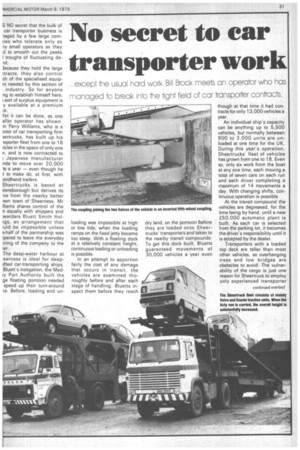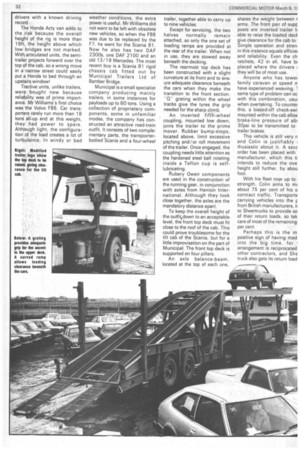No secret to ear transporter work
Page 33

Page 34

If you've noticed an error in this article please click here to report it so we can fix it.
...except the usual hard work. Bill Brock meets an operator who has managed to break into the tight field of car transporter contracts.
S NO secret that the bulk of car transporter business is -iaged by a few large corniies who tolerate only as ly small operators as they .d to smooth out the peaks I troughs of fluctuating de
3ecause they hold the large vtracts, they also control ch of the specialised equipnt needed by this section of industry. So for anyone ng to establish himself here, ; sort of surplus equipment is y available at a premium e.
Yet it can be done, as one aller operator has shown. in Parry Williams, who is a ;ctor of car transporting firm eertrucks, has built up his isporter fleet from one to 18 tides in the space of only one ir, and is now contracted to Japanese manufacturer nda to move over 20,000 ts a year — even though he 1 to make do, at first, with ondhand trailers.
Sheertrucks is based at eensborough but derives its ne from the nearby better Awn town of Sheerness. Mr lliams shares control of the n equally with shippers and warders Bluett Smith Hollgs, an arrangement that iuld be impossible unless e-half of the partnership was pared to leave the everyday )ning of the company to the
The deep-water harbour at eerness is ideal for deep;fted car-transporting ships. Bluett's instigation, the Medly Port Authority built the ge floating pontoon needed speed up their turn-around le. Before, loading and un
loading was impossible at high or low tide, when the loading ramps on the fixed jetty became too steep. With a floating dock at a relatively constant height, continuous loading or unloading is possible.
In an attempt to apportion fairly the cost of any damage that occurs in transit, t1-p.e vehicles are examined thoroughly before and after each stage of handling. Bluetts inspect them before they reach
dry land, on the pontoon before they are loaded onto Sheertrucks' transporters and taken to the nearby transit compounds. To get this dock built, Bluetts guaranteed movements of 30,000 vehicles a year even though at that time it had contracts for only 13,000 vehicles a year.
An individual ship's capacity can be anything up to 5,500 vehicles, but normally between 900 to 3,000 units are unloaded at one time for the UK.
During this year's operation, Sheertrucks' fleet of vehicles has grown from one to 18. Even so, only six work from the boat at any one time, each moving a total of seven cars on each run and each driver completing a maximum of 14 movements a day. With changing shifts, continuous operation is possible.
At the transit compound the vehicles are degreased, for the time being by hand, until a new £50,000 automatic plant is built. As each car is selected from the parking lot, it becomes the driver's responsibility until it is accepted by the dealer.
Transporters with a loaded top deck are taller than most other vehicles, so overhanging trees and low bridges are obstacles to avoid. The vulnerability of the cargo is just one reason for Sheertruck to employ only experienced transporter drivers with a known driving record.
The Honda Acty van adds to the risk because the overall height of the rig is more than 16ft, the height above which low bridges are not marked. With articulated units, the semitrailer projects forward over the top of the cab, so a wrong move in a narrow street could easily put a Honda to bed through an upstairs window!
Tractive units, unlike trailers, were bought new because reliability was of prime importance. Mr Williams's first choice was the Volvo F86. Car transporters rarely run more than 18 tons all-up and at this weight, they had power to spare. Although light, the configuration of the load creates a lot of turbulence. In windy or bad weather conditions, the extra power is useful. Mr Williams did not want to be left with obsolete new vehicles, so when the F86 was due to be replaced by the F7, he went for the Scania 81. Now he also has two DAF 2300s, one OAF 2100 and an old 13/19 Mercedes. The most recent buy is a Scania 81 rigid chassis cab fitted out by Municipal Trailers Ltd of Bamber Bridge.
Municipal is a small specialist company producing mainly trailers, in some instances for payloads up to 60 tons. Using a collection of proprietary components, some in unfamiliar modes, the company has constructed an attractive road-train outfit. It consists of two complementary parts, the transporterbodied Scania and a four-wheel trailer, together able to carry up to nine vehicles.
Except for servicing, the two halves normally remain attached, so only the one set of loading ramps are provided at the rear of the trailer. When not in use, they are stowed away beneath the decking.
The rearmost top deck has been constructed with a slight curvature at its front and to ensure adequate clearance beneath the cars when they make the transition to the front section. "Q" grating within the wheel tracks give the tyres the grip needed for the sharp climb.
An inverted fifth-wheel coupling, mounted low down, joins the trailer to the prime mover. Rubber bump-stops, located above, limit excessive pitching and/or roll movement of the trailer. Once engaged, the coupling needs little attention as the hardened steel ball rotating inside a Teflon cup is selflubricating.
Rubery Owen components are used in the construction of the running gear, in conjunction with axles from Hanton International. Although they look close together, the axles are the mandatory distance apart.
To keep the overall height of the outfitedown to an acceptable level, the front top deck must fit close to the roof of the cab. This could prove troublesome for the tilt cab of the Scania, but for a little improvisation on the part of Municipal. The front top deck is supported on four pillars.
An axle balance-beam, located at the top of each one,
shares the weight between 1 arms. The front pair of supr posts are inverted trailer h able to raise the loaded decl, give clearance for the cab to Simple operation and stren in this instance equals efficiel and reliability. Even the ch ratchets, 42 in all, have br placed where the drivers they will be of most use.
Anyone who has tower family caravan at speed n have experienced weaving. 1 same type of problem can oc with this combination, usui when overtaking. To counter this, a biased-off check-swi mounted within the cab allolA brake-line pressure of al), 30psi to be transmitted to trailer brakes.
This vehicle is still very r and Colin is justifiably thusiastic about it. A secc order has been placed with manufacturer, which this ti intends to reduce the ove height still further, by abou foot.
With his fleet now up to strength, Colin aims to mr about 75 per cent of his o
contract traffic. TransportE carrying vehicles into the r from British manufacturers, to Sheertrucks to provide so of their return loads, so tak care of most of the remaining per cent.
Perhaps this is the m positive sign of having mad into the big time, for • arrangement is reciprocated other contractors, and ShE truck also gets its return load












































































































